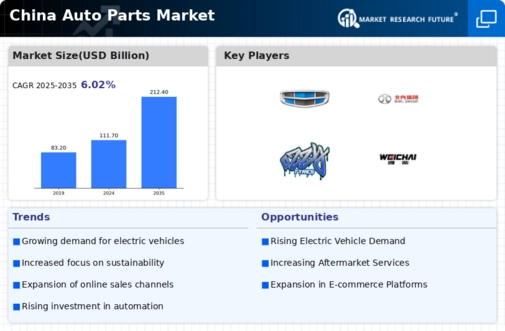Growth of E-commerce Platforms
The rise of e-commerce platforms in China significantly impacts the auto parts market, providing consumers with easier access to a wide range of products. Online sales channels have expanded rapidly, with platforms like Alibaba and JD.com facilitating the purchase of auto parts directly from manufacturers. In 2025, it is estimated that online sales will account for over 30% of total auto parts sales in China. This shift towards digital commerce allows consumers to compare prices, read reviews, and access a broader selection of parts, thereby enhancing their purchasing experience. The auto parts market is adapting to this trend by investing in online marketing strategies and improving logistics to meet the growing demand for online shopping.
Rising Vehicle Ownership Rates
The auto parts market in China experiences a notable boost due to the increasing vehicle ownership rates. As urbanization continues to rise, more individuals are purchasing vehicles, leading to a higher demand for auto parts. In 2025, the vehicle ownership rate in China is projected to reach approximately 300 million units, which translates to a significant increase in the need for replacement parts and accessories. This trend is further supported by the growing middle class, which is likely to invest in personal vehicles. Consequently, the auto parts market is poised to benefit from this surge in demand, as manufacturers and suppliers adapt to meet the needs of a larger consumer base.
Government Regulations and Standards
The auto parts market in China is heavily influenced by government regulations and standards aimed at enhancing vehicle safety and environmental performance. The Chinese government has implemented stringent regulations that require auto parts to meet specific safety and emissions standards. For instance, the implementation of the China VI emission standards is expected to drive demand for advanced components that comply with these regulations. This regulatory environment encourages innovation within the auto parts market, as manufacturers strive to develop compliant products. As a result, the market is likely to see an increase in the production of high-quality, eco-friendly auto parts, which could potentially lead to a more sustainable industry.
Increasing Focus on Aftermarket Services
The auto parts market in China is experiencing a shift towards aftermarket services, driven by the growing awareness of vehicle maintenance among consumers. As vehicle ownership increases, so does the need for regular maintenance and repairs, leading to a burgeoning aftermarket sector. In 2025, the aftermarket segment is projected to account for nearly 50% of the total auto parts market revenue. This trend indicates a shift in consumer behavior, where individuals are more inclined to invest in quality replacement parts and services. The auto parts market is responding by enhancing service offerings and promoting high-quality aftermarket products, thereby fostering customer loyalty and satisfaction.
Technological Advancements in Manufacturing
Technological advancements in manufacturing processes are reshaping the auto parts market in China. The adoption of automation, artificial intelligence, and advanced materials is enhancing production efficiency and product quality. For instance, the integration of robotics in assembly lines is expected to reduce production costs by up to 20% while improving precision. These innovations not only streamline operations but also enable manufacturers to respond more swiftly to market demands. As a result, the auto parts market is likely to witness a surge in the availability of high-performance components, catering to the evolving needs of consumers and automotive manufacturers alike.















Leave a Comment